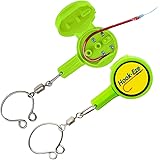Bass fishing is a thrilling sport that can be enjoyed by people of all ages and skill levels. Whether you’re new to the hobby or an experienced angler, catching big bass can be challenging but incredibly rewarding. In this guide, we will explore some of the best lures for catching big bass, as well as other tips and tricks to help you land your next trophy-sized catch.
Introduction to Bass Fishing
Bass are one of the most popular types of freshwater fish in North America, and they are known for their strength and aggressive fighting style. There are several different species of bass, including largemouth, smallmouth, spotted, and striped bass. Each type has its own unique characteristics and habits, which makes them exciting and unpredictable to catch.
Best Lures for Catching Big Bass
When it comes to choosing the right lure for bass fishing, there are many options available. Here are five of our top picks:
1. Spinnerbait – This versatile lure works well in both shallow and deep water, and can be used to target bass at any time of day. It features a metal blade that creates vibrations and flashes, mimicking prey like shad or minnows.
2. Jig – A jig is a heavy weight with a hook on one end and a trailer (usually plastic) on the other. It is great for bottom feeders and can be worked slowly along the bottom to entice strikes from large bass.
3. Topwater frog – This lure imitates a frog sitting on the surface of the water, making it perfect for use during early morning or late evening when frogs are active. The sound of the lure splashing across the water can attract hungry bass from far away.
4. Worm – Soft plastic worms are a classic choice for bass fishing because they resemble the natural food source of bass such as crawfish or earthworms. They work especially well in murky waters where visibility is low.
5. Swimbait – These lures look like swimming baitfish and have become increasingly popular among bass anglers. They come in various sizes and colors, allowing you to match the size and color of local baitfish populations.
Where to Go Bass Fishing
One key factor in successful bass fishing is finding the right location. Some ideal places to go bass fishing include lakes, rivers, ponds, and even manmade impoundments. Look for areas with plenty of cover, such as vegetation, rocks, or fallen trees. Also consider the depth of the water and the presence of structure like drop offs or ledges.
How to Catch Big Bass
Once you have chosen the right lure and found a promising spot, it’s time to start casting! When using a spinning rod, try to keep your line tight and let the lure sink to the desired depth before retrieving it back towards shore. With a baitcasting reel, you can cast further distances and control the speed and direction of your retrieve more precisely. Don’t forget to experiment with different speeds and techniques until you find what works best for each individual fish.
Equipment for Bass Fishing
In addition to the right lures and tackle, there are several pieces of equipment that can enhance your bass fishing experience. A quality fishing rod and reel combo is essential, as well as high-quality line and terminal tackle. You may also want to invest in polarized sunglasses to reduce glare and improve visibility underwater.
What Lures to Use for Bass Fishing
As mentioned earlier, there are countless varieties of baits and lures designed specifically for bass fishing. Ultimately, the decision should depend on factors such as weather conditions, seasonal patterns, and the behavior of the bass themselves. For example, if the water temperature drops below 60 degrees Fahrenheit, bass tend to slow down and become less active, so larger profiled lures like jigs or creature baits might be better suited for colder temperatures. Conversely, during warmer months, smaller profiled lures like crankbaits or soft plastics could trigger more bites due to increased activity level of bass.
Teaching My Child to Bass Fish
Fishing is not only a fun pastime but also a valuable opportunity to bond with family members and teach important life skills. If you have children who show interest in learning how to bass fish, here are some tips to get started:
1. Choose age-appropriate gear – Start with lightweight rods and reels suitable for young hands and fingers.
2. Keep it simple – Begin with basic techniques like casting and retrieval before moving onto more complex tactics.
3. Practice safety first – Teach kids about proper handling of fishing gear and always wear appropriate personal flotation devices while boating.
4. Make it fun – Encourage creativity and imagination by letting kids design their own lures or decorate their fishing poles.
How to Fish for Bass from My Boat
If you prefer to fish from a boat, there are additional considerations to take into account. First, make sure your vessel is properly equipped with necessary safety gear and navigation tools. Then, choose a reliable outboard motor that provides enough power to move through the water efficiently without disturbing the fish. Finally, pay attention to wind direction and current flow, as these factors can affect your ability to effectively present your lures to the bass.
































































